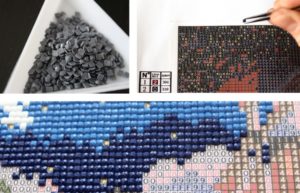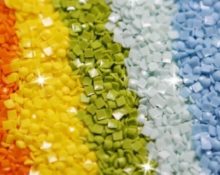Diamond embroidery is a new type of exciting creativity that has appeared relatively recently. But he has already acquired an army of fans from around the world. This activity first originated in China, and its ancestor was the ancient technique of laying out mosaics.
The process of creating paintings is quite simple and exciting. The end result always delights and pleases. Absolutely simple needlework, accessible even to a child. However, there are several nuances with which the diamond painting technique will help you complete the job more professionally.
What can be used to attach rhinestones in diamond mosaic?
 In order to gain experience, it is better for beginning craftswomen or children purchase an inexpensive simple set with a small number of colored fragments. You can choose a canvas with or without a stretcher. If you plan to decorate it in a framing workshop, then buy without it. Also, the shape of the rhinestones - square or round - does not matter significantly. In any case, the finished result will be amazing.
In order to gain experience, it is better for beginning craftswomen or children purchase an inexpensive simple set with a small number of colored fragments. You can choose a canvas with or without a stretcher. If you plan to decorate it in a framing workshop, then buy without it. Also, the shape of the rhinestones - square or round - does not matter significantly. In any case, the finished result will be amazing.
As for the glue, then it comes with the kit, and, as a rule, it should be enough for the whole picture. If it happens that it was not enough, then the craftswomen recommend using double-sided tape, as well as Moment (gel) or Titan glue, but it first takes some time for it to “set.” You can also find glue “For gluing puzzles” in stores. In any case, you must first try the glue on a small piece of canvas.
For work we will need:
- canvas with a finished image with a sticky layer;
- tweezers or glue stick;
- scissors or stationery knife;
- acrylic rhinestones;
- towel;
- rolling pin;
- tray or organizer.
Usually, ready-made kits already have all the necessary ingredients, but if you only bought a pattern and rhinestones, then it’s not difficult to pick up the rest. Just in case stock up on special glue, if the sticky base suddenly dries out. It is sold in craft stores.
How to properly prepare a diagram for gluing?
 First you need to prepare the basis for the image. Its alignment is an important point, which will greatly facilitate the process itself. Heat the iron to the minimum temperature and carefully iron through a thin cotton fabric from the wrong side. If this method confuses you and you are afraid of ruining the canvas, since it has an adhesive surface, then simply place something heavy on top of it overnight. For example, a cardboard box, books or glass.
First you need to prepare the basis for the image. Its alignment is an important point, which will greatly facilitate the process itself. Heat the iron to the minimum temperature and carefully iron through a thin cotton fabric from the wrong side. If this method confuses you and you are afraid of ruining the canvas, since it has an adhesive surface, then simply place something heavy on top of it overnight. For example, a cardboard box, books or glass.
Step by step process on how to glue
 You have already purchased a set with a ready-made diagram, lay it out on a flat surface with the pattern facing up. When starting to create a picture, separate a small part of the protective film from the upper left corner. Finish the work at the bottom right, so you will not spoil the finished surface with a careless movement of your hand.
You have already purchased a set with a ready-made diagram, lay it out on a flat surface with the pattern facing up. When starting to create a picture, separate a small part of the protective film from the upper left corner. Finish the work at the bottom right, so you will not spoil the finished surface with a careless movement of your hand.
Lay out this fragment with crystals corresponding to the numbers of this section (they are designated by numbers on the bag). It’s better to immediately pour several rhinestones into the organizer’s compartments and take them out one at a time, placing them along the contour.
Important! For round beads, a pressing pencil is most convenient to use; for square beads, tweezers with thin tips are suitable.
Try to lay out exactly in the designated squares, otherwise the displacement of the pattern will look sloppy and ruin the whole look. When you can’t do this right away, remove the diamond from this place with tweezers and reapply it. For better grip, you can press a little on top with your finger.
If everything turned out great, the rhinestones lie flat, and you are happy with the result, it’s time to secure it. This is done using a rolling pin or other cylindrical object.. Cover the pattern with a soft towel and roll it with light pressure.
How to work with an already completed painting?
To add gloss and protect the product from dust and moisture, it is allowed to coat it with colorless acrylic varnish in one or several layers. Especially when your plans do not include placing it under glass. Carefully trim the cotton edge with scissors. We insert it into the prepared passe-partout or directly into the frame. For it, take a large-format photo frame, baguette or a frame made by yourself. It works great from ceiling plinth coated with acrylic paints.
Such a painting can not only decorate a residential or office space, but will also become an exquisite gift for any special occasion.


 0
0






Hello. I need your advice.
I am engaged in diamond embroidery. Everything is working out great. I make icons under glass. In one of the master classes I read that the finished painting needs to be varnished. I covered the last two icons, one with acrylic varnish, the others with colorless nail varnish. The acrylic has lost the shine of its edges, although it is colorless and glossy. Do you cover diamond embroidery with any varnish and is it necessary to do so?
Hello!
Whether or not to varnish the finished work is a personal matter for each master. Usually the coating is applied for various reasons: to prevent dust from settling or to make the work more durable. But if you make paintings under glass, then I personally don’t see the benefit of varnishing. Any varnish kills the beauty of rhinestones. Of course, they will shine, but the edges will already take on a more rounded shape, and therefore will not shimmer in the light as effectively as uncoated ones. To prevent rhinestones from falling off, it is enough to purchase high-quality sets or additionally buy special glue for rhinestones for such cases.
Could you recommend glue for rhinestones?